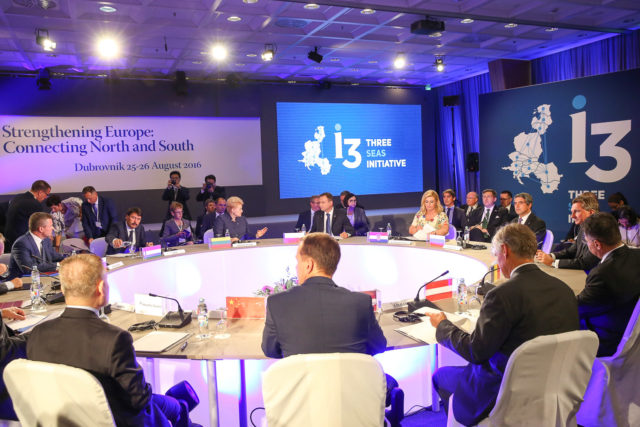
Poland’s Intermarium Idea Very Different From What It Was—or What Moscow Thinks It Is
Publication: Eurasia Daily Monitor Volume: 17 Issue: 127
By:

Russian analysts fail to recognize that Warsaw no longer views the Intermarium—a historical term that today refers to the lands “in between” Russia and the West and the Baltic and Black Seas—as it did in the 1920s and 1930s but rather conceives it as a means for the integration of a broader area, including Russia, to the benefit of all, Michał Sadłowski, a professor of law at the University of Warsaw, says (Nezavisimaya Gazeta, September 14). And Russia’s inability to understand that reality risks becoming a self-fulfilling prophecy, leading Moscow to take actions that could drive Warsaw back to its older conception of promoting “the countries in between” Poland and Russia as a cordon sanitaire or defensive buffer against Russian aggression (Marek Chodakiewicz, Intermarium: The Land Between the Black and Baltic Seas, Transaction Publishers, 2012; Politcom.ru, June 1, 2016; Riafan.ru, June 21, 2016; Riata.ru, June 16, 2016).
In an important article in Moscow’s Nezavisimaya Gazeta yesterday (September 14), Sadłowski bluntly contends that Polish ideas about the lands in between, “the Polish Intermarium,” are no longer, if they ever were, “an imperial conception.” Treating them as if they are what they may have been a century ago is thus a dangerous misconception, which can lead to the deterioration of relations between Russia and Poland and to new tensions across a region already under multiple strains (Nezavisimaya Gazeta, September 14).
“Undoubtedly,” he writes, “the territory of Central-Eastern Europe and, above all, the portion of it that, until recently, was within the Soviet Union has again become a space” where new unifications and divisions are taking place with remarkable speed. In this, “one can name Warsaw and Moscow as the two ideological centers of this process,” centers whose ideas often are at odds. Indeed, many Russian writers in talking about Poland’s ideas about the Intermarium act as if nothing had changed in Warsaw’s thinking since the 1920s and 1930s and that Polish references to its policies toward the countries in between are only an updated version of what they see as an older “Polish imperial project.” But in fact, there has been an important evolution, the legal scholar argues.
Ideas about the Intermarium extend well into the past and have changed over time, Sadłowski notes. In the 1920s and 1930s, Warsaw believed that the emergence and strengthening of the countries in between Poland and Russia could serve as a defensive buffer against any Russian revanchism. “In this sense,” he continues, “the idea of the Intermarium arose as a response to the imperialism of the Russian tsars and, then, as a response to the expansion of the Soviet state.” Some of the Polish advocates of this idea at that time imagined that, in due course, they could create a federal state consisting of all these countries. However, such hopes repeatedly came to nothing because all of the countries in between wanted to retain their own independence.
Both before World War II and afterward (primarily in the diaspora), Polish scholars recognized that the old, interwar conception of the Intermarium needed to be modified. Among the most important of the advocates for change were Jerzy Giedroyc, who for many years edited the influential Paris-based magazine Kultura, and Juliusz Mieroszewski, who wrote widely about international affairs from his home in London. They, more than their predecessors, are responsible for developing the new conception of the Intermarium, the one on which Warsaw relies today but that Moscow has failed to recognize.
Giedroyc and Mieroszewski argued, Sadłowski explains, that Poland must give up any aspirations to reclaim territories to the east and also any desire to subordinate the countries in this region to itself. Instead, it must promote democracy and cooperation in these states as the best means of boosting their security and Poland’s. After the collapse of the Soviet Union, this view became predominant as Poland, and many of its neighbors experienced their own “end of history moment.” And at that time, Warsaw made clear that it wanted to support the sovereignty of its eastern neighbors not so much to put pressure on Russia as an end in itself, but because this would eventually facilitate the transformation of Russia as well. Such a conception, Warsaw officials and commentators said, could help reduce old and future tensions between Poland and the Russian Federation.
According to Sadłowski, overcoming those tensions will not be easy; but a major first step will be for all concerned to recognize that what Poland means by Intermarium now is not what it meant in the 1920s. If Russian thinkers continue to insist otherwise, the Polish scholar suggests, progress will be difficult and may even be reversed by a tragic self-fulfilling prophecy in which Moscow will act in ways that force Warsaw to consider a return to its earlier conception.
The appearance of this article in Moscow now is especially important for at least two reasons. First, it challenges Russian suggestions that Warsaw is involved in seeking to pull Belarus away from Russia or even make claims on what is now Belarusian territory. And second, it provides a much-needed corrective to those Russian writers who have conflated the original notion of the Intermarium with the Three Seas Initiative (strongly encouraged by the United States) and the development of a Baltic–Black Sea waterway across Ukraine, Belarus and Poland (Qha.com.ua, June 5, 2016; Postimees, December 19, 2019; see EDM, April 28, May 4, 13).
If Moscow cannot escape from its misconceptions about the nature of contemporary Polish thinking on the Intermarium countries, the consequences will be serious and negative—not only for Poland and Russia and the countries in between but also for East-West relations as a whole, including the US and the North Atlantic Treaty Organization (NATO). Proper understanding and contextualization matters. And Sadłowski’s article represents a major contribution to that task.



